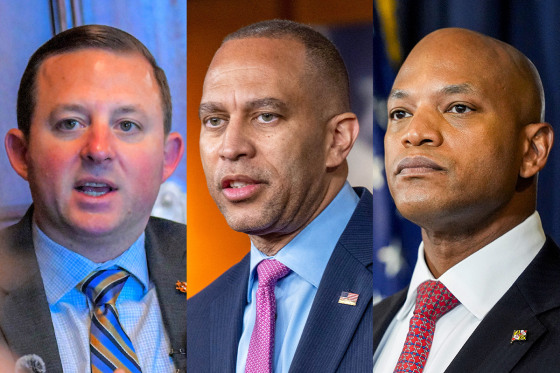Maryland Senate President Bill Ferguson’s pronouncement this week that he wouldn’t pursue a new congressional map has set off a round of infighting in the state Democratic Party.
But even in the face of pressure from Democratic leaders in the state and nationally, Ferguson isn’t budging, saying there aren’t the votes for a mid-decade redistricting push in his chamber.
“I would not be great at my job if I didn’t know where my members stood,” Ferguson said in an interview with NBC News Friday.
Ferguson is one of a small group of lawmakers in Maryland and around the country vocally resisting their party’s demand to redraw congressional lines ahead of next year’s midterm elections, amid a feverish redistricting arms race between Republican- and Democratic-led states.
In a long letter to Senate colleagues on Tuesday evening explaining why he wouldn’t call a special legislative session, Ferguson said “the risk of redrawing the congressional map in Maryland is too high.”
Since then, the pressure has only escalated. Maryland Gov. Wes Moore told reporters earlier this week that “one person cannot stop a process” and “a special session is not off the table, regardless of what anyone else says.” House Minority Leader Hakeem Jeffries, D-N.Y., told reporters that Maryland “understands the assignment and as we are seeing in multiple other states will respond aggressively and appropriately in short order.”
What began with President Donald Trump urging Texas Republicans over the summer to redraw their congressional lines to shore up the party’s U.S. House majority has led to a flood of states across the country enacting or considering new maps outside of the usual decennial redistricting cycle.
In an interview, Ferguson expressed concern about the broader impact of additional states joining the fray to enact more partisan maps.
“The path that we are on is unsustainable, and nobody wants to or feels that they should unilaterally disarm. I don’t think that’s what this is,” he said. “I think this is leaning into a reality of — if we want to protect this democracy in the future, we have got to chart a different path.”
Ferguson said he’s been in talks with other state leaders — Republicans and Democrats — about the redistricting arms race.
“There is a fundamental question that I hope that every chamber leader across the country in state legislatures is asking themselves,” he said. “What type of country do we want to be? And who are we in this moment when things are so brittle and tense. Do we reflect a different value to show the path forward as states, or do we fight to the death one election at a time?”
But with control of Congress up for grabs in the 2026 elections — and with it, the fate of much of the rest of Trump’s second-term agenda — there’s plenty of political incentive on both sides to pursue new maps.
Virginia Democrats took the first step toward redrawing their state’s maps this week, which would require modifying their redistricting commission with a constitutional amendment. On Tuesday, California voters are expected to approve a map that draws five new Democratic seats in an effort to neutralize Texas’ new district lines.
Missouri and North Carolina have enacted new maps designed to net the GOP an additional House seat. In Ohio, a bipartisan redistricting commission approved a new map on Friday that boosts Republicans, but not to the degree some Democrats had feared.
National Democrats continue to pressure Illinois’ Democratic lawmakers to draw a new map, while Indiana Republican Gov. Mike Braun has called for special session to deal with redistricting, though it’s unclear if there is enough support in the GOP-controlled Legislature for such an effort.
Florida’s Republican Gov. Ron DeSantis said this summer that people can “anticipate” a mid-decade redraw in that state. And Kansas Republicans are considering a similar move.
Pressed on the political realities, Ferguson argued that nothing is inevitable.
“Nothing happens just because. It happens because people make a choice,” he said. “At the end of the day, this comes down to more than just lines on a map. Here are core questions about the future of our democracy that are embedded in how elections are set and who represents the people of a jurisdiction.”

